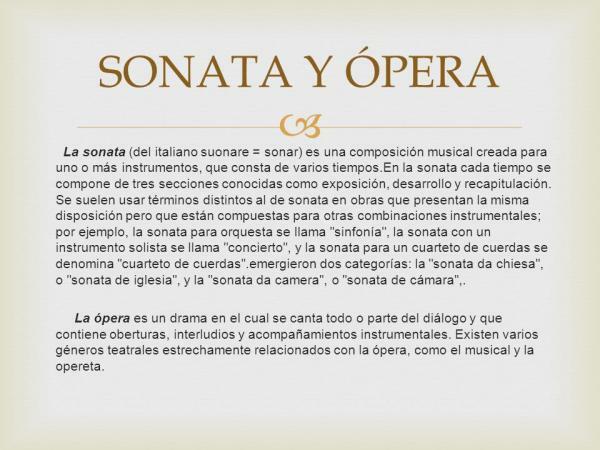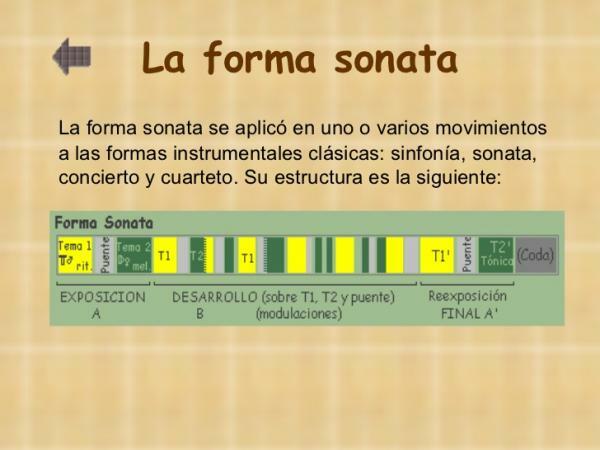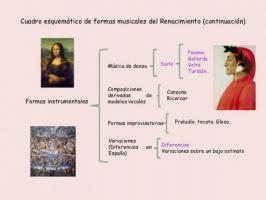SONATA musical: definition + characteristics

Serenade, night, concert ... They are some of the terms that we frequently hear when we speak of classical music. Despite this, we don't always really know what they really mean. You may have heard the word "sonata" but have you ever wondered where this term comes from, and what does it mean in the context of music? In this lesson from a TEACHER we will talk about what is a musical sonata and what are the characteristics in this classical form that has formally subsisted since classicism.
The sonata is a classical musical formthat branches out in variations according to the time, since it has lasted for a long time, having its origin in the period classicism and continuing even in contemporary music.
According to the classical model, the sonata is a complete musical piece, generally composed for musical groups of less than 3 instruments which is composed of movements (usually 4) and has a compositional development where they are exposed two themes that usually contrast each.
We can also find sonatas not only as works themselves, but even within other musical compositions such as
symphonies, quartets or concerts. It is also worth mentioning that there is sonatina, which is when the structure of the sonata is applied to smaller pieces.As a classic idea, the sonata is one of the most popular types of composition, having hundreds of notable composers in making musical works with this form. Among them we find Johann Sebastian Bach, Domenico Scarlatti, Franz Schubert, Piotr Ilich Tchaikovsky, Wolfgang Amadeus Mozart, Ludwig Van Beethoven, Muzio Clementi, Sergei Rachmaninoff, Franz Liszt, Frederic Chopin, Johannes Brahms, Robert Schumann, Samuel Barber, Maurice Ravel, Sergei Prokofiev and Dimitri Shostakovich among others.
The sonata has its beginnings in the Musical baroque. At first the name of sonata to name reduced instrumental works, in contrast to the cantata, which were works for the voice. But, over time, the form of the sonata developed, acquiring subgenres and characteristics varied, depending on the instrumentation used or its structure and the way of developing the thematic.
It's not up to the composers Johann Sebastian Bach and Friedrich Händel during the classicism that the form acquires a certain structure. From this structure there have been small variations, mainly subject to the amount or type of movements and the instrumentation used.
For the 9th and 20th centuries it could be said that it could reach a maximum development thanks to the inclusion of new instruments and, together with the leakage, became one of the fundamental methods for organizing, analyzing and interpreting concert music.

Image: Slideplayer
Now that you know what a musical sonata is, let's see the structure of this piece. Let us remember that, depending on the time, the form of the sonata may change but, in general terms, the sonata is made up of 4 movements, the first being the most complex.
First Movement, Allegro de sonata
It is made up of 3 parts:
- Exposition: Where the main themes of the work are presented. In this case, the topics are 2. The main theme is in the base key, while the other is in some neighboring key. Both themes are connected by means of the melody to make the transition.
- Developing: It usually has a free structure but keeps the themes of the exhibition in mind, transforming them for variations and playing with them. Development is the point of greatest excitement or tension in the sonata, often due to the tonal instability that is created.
- Recap or restatement: The themes of the exhibition reappear, this time both in the main key.
Second movement
It is slow, using the forms of andante, adagio or long.
Third movement
Use dance forms like the minuet or scherzo.
Fourth Movement
Other allegro, but less complex and structured than the allegro of the first movement. It is also combined with the rondo shape.

Image: Slideshare
We finish this lesson on what a musical sonata is by talking about the main composers of this type of musical piece so that you can learn more about their works.
- Baroque Period: Johann Sebastian Bach, George Friedrich Händel, Domenico Scarlatti.
- Classical period: Joseph Haydn, Wolfgang Amadeus Mozart, Ludwig van Beethoven, Muzio Clementi.
- Romantic period: Franz Schubert, Robert Schumann, Frederic Chopin, Franz Liszt, Sergei Rachmaninoff, Piotr Tchaikovsky, Edward Elgar, Johannes Brams, Felix Mendelsshon.
- Twentieth century: Maurice Ravel, Claude Debussy, Igor Stravinsky, Dimitri Shostakovich, Sergei Prokofiev, Bela Bartok, Aaron Copland, Benjamin Britten.
Now that you know what is a musical sonata Thanks to this article by a TEACHER, you can dedicate yourself to listening to some exemplary works in this way so that you can better understand what you have learned.



